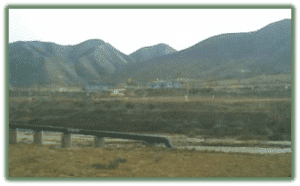iEnvironmental Principal Michael Nicholls and his team were selected by the Gansu and Baiyin Government from an Australian Foreign Affairs expert delegation, to design a strategy for agricultural soil remediation in a short time frame, for a large area that was used for corn and wheat crops, and irrigated using smelter and various industrial processing plant’s wastewater. The soil was adversely impacted on a large scale with harmful concentrations of Hg, As, and Cd.
The total volume of the pilot trial site (which may not in other countries be considered ‘pilot scale’) requiring an active (non-blending) remediation was 26,000m3, and the greater remediation site was 2,400,000m3.
The approach was selected that treated the selected crop root zone (the future crops were selected in part based on root depth) soils, to 1m depth, including soil washing and blending. Generally, maximum soil washing processing rate is approximately 100m3 per day. However, a combination method was selected utilising a mobile Matrix Enhanced Treatment System (METS) where the soil surface contact area is dramatically increased at the same time as the washing chemical injection period allowing up to 6,000m3 per day process of soil.
As and Hg and Cd, Innovative Remediation, Soil Remediation, Agricultural Soil
The method selected essentially involved:
1. Excavation of soil and treatment processing and metered dosing via the METS system with an injection of EDTA.
2. Cadmium chelation from soil to the liquid wash.
4. Dimercaprol (2,3-dimercapto-1-propanol) for arsenic and mercury chelation into the liquid wash.
5. Ferric chloride and ferric sulphate flocculent for arsenic and mercury precipitation from the wash.
6. The suggested target level of 3-6mg/kg of cadmium, to be trialled via a toxicology risk assessment with a small plot.
7. Lower concentrations of soil at 0.6 to 1.0 metres below the surface would be blended.
In order to decrease the transferring of heavy metals into the soil and plants, and to improve the soil fertility for agricultural production, a rational recipe of soil amendments was developed according to the soil properties and crops, soil metal concentrations, as well as the local materials available. The main materials included: red mud (immobilising materials, at 750 kg/mu), Cd-free lime (for pH adjusting), clean organic manures (such as compost for soil fertility improvement, at 500 kg/mu) – sourced from nearby Gansu Linze Dairy Farm Biogas Plant Linze county, plant straw powder (immobilising materials, at 200 kg/mu), clay minerals (bentonite or zeolite, at 300 kg/mu), and other materials.
Following remediation, the site was to be used as a pilot for testing crop uptake against toxicity (Food Administration) thresholds.


